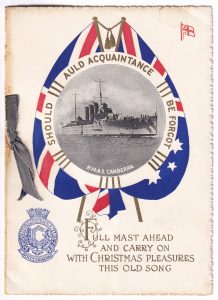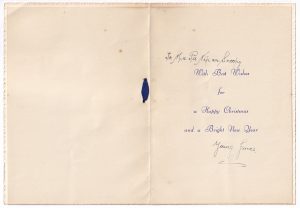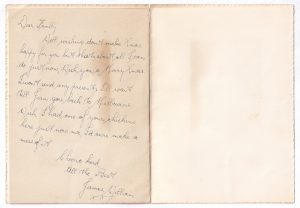[Editor: This Christmas card, with a photo of HMAS Canberra, and bearing the HMAS Canberra badge, includes the British flag (Union Jack) and the Australian flag (blue ensign). The card is undated, but was presumably printed between 1929-1941.]
[HMAS Canberra, Christmas card]
[Front of card]
Should auld acquaintance be forgot
[A photo of H.M.A.S. Canberra, decorated with the British flag (Union Jack) to its left, and the Australian flag (blue ensign) to its right. The badge of H.M.A.S. Canberra appears in the bottom left section of the card.]
Full mast ahead
and carry on
with Christmas pleasures
this old song
[Inside of card, middle]
[Handwritten text, in italics]
To Ma Pa Nip an Snoopy
With Best Wishes
for
a Happy Christmas
and a Bright New Year
Young James.
[Inside of card, end]
[Handwritten text, in italics]
Dear Fambly,
Well, wishing don’t make Xmas happy for you, but that’s about all I can do just now, Wish you a Happy Xmas.
I won’t send any presents, I’ll wait till Jean goes back to Melbourne.
Wish I had one of your chickens here just now ma, I’d sure make a mess of it.
Cheerio herd,
All the Best.
James William
xxx
[No identifying information about the manufacturer was included on the postcard.]
Source:
Original document
Editor’s notes:
Dimensions (approximate): 114 mm. (width), 158 mm. (height) (measurements of front cover).
Considering the light-hearted or humorous nature of the writer of this card (as evidenced in the signing-off line “Cheerio herd”), two phrases have been left as is, rather than being changed or corrected, as they both may have been written tongue-in-cheek: “Nip an Snoopy” (“Nip and Snoopy”) and “Dear Fambly” (“Dear Family”).
On the back of the card are two handwritten notations, “Sunk 1942” and “£6”; these were presumably added some years later by a seller.
The writer of this Christmas card may have been James William Clifford, who enlisted on 4 September 1939, and who served on HMAS Canberra (discharged 15 November 1939).
See: “Clifford, James William”, Virtual War Memorial Australia [Service Number: PA1506; Enlisted: 4 September 1939, Port Adelaide, SA; Last Rank: Seaman; Last Unit: HMAS Canberra (I); Born: Pt Pirie, SA, 12 November 1919]
Notes:
1) Genealogy SA has a listing for James William CLIFFORD, born in 1918 (Father: James Alfred CLIFFORD; District: Clare; Book/Page: 27A/485; Birth Year: 1918) [the year of birth given by Genealogy SA (1918) is different to the year given by Virtual War Memorial Australia (1919), but there may be a transcription error involved on one of the sites]
2) The National Archives of Australia site has a digitized copy of James William Clifford’s “Record of Mobilized Service” (Royal Australian Naval Reserve), which records him as being on Cerberus IV (4-9-39 to 4-9-39), on the Canberra (5-9-39 to 7-11-39), and then on Cerberus IV again (8-11-39 to 15-11-39).
3) However, the signatures does not appear to match. Whilst the RANR form does not include his full signature, it shows that his initial “J” is different. On the “Record of Mobilized Service” the J curves out directly to the left at the top, whilst on the Christmas card the J curves to the right at the top and then over to the left.
See: “CLIFFORD JAMES WILLIAM : Service Number – PA1506 : Date of birth – 12 Nov 1919 : Place of birth – PT PIRIE SA : Place of enlistment – PORT ADELAIDE SA : Next of Kin – CLIFFORD F”, National Archives of Australia (“Record of Mobilized Service”)
auld = (Scottish) old
HMAS = “Her Majesty’s Australian Ship”, or “His Majesty’s Australian Ship”, depending on the sex of the ruling monarch; a designation given to a base or a ship of the Royal Australian Navy (the designation may be rendered as “HMAS” or “H.M.A.S.”)
HMAS Canberra = a heavy cruiser of the Royal Australian Navy, built in Scotland, commissioned in 1928, arrived in Australian waters in 1929, performed military patrol and escort duties during World War Two (1939-1945); it was severely damaged by Japanese warships during the Battle of Savo Island (8-9 August 1942) and was subsequently scuttled
See: 1) “HMAS Canberra (I)”, Royal Australian Navy
2) Lt. Cdr. Geoffrey B. Mason, RN (Rtd.), “HMAS Canberra – County-type Heavy Cruiser”, Naval-History.net
3) Dr. Chris Clark “Remembering 1942: The Loss of HMAS Canberra”, Australian War Memorial (Canberra), 9 August 2002
4) “HMAS Canberra (D33)”, Wikipedia
Ma = mama, mother (commonly capitalised when used regarding a specific person, such as one’s own mother)
Pa = papa, father (commonly capitalised when used regarding a specific person, such as one’s own father)
should auld acquaintance be forgot = the first line of the song “Auld Lang Syne”; the song was written by Robert Burns (1759-1796) in 1788, based upon an old Scottish folk song
x = a symbol for a kiss (depending on the circumstances, it may indicate a loving kiss, a familial kiss, or a friendly kiss)
Xmas = an abbreviation of “Christmas”



Dear Ed.
Your comments educate us on some research locations, so this time I decided to emulate you, instead of lazily sitting back and forcing you to do all the work.
So: Firstly, I used my internet search engine to search for “australian war memorial” and “royal australian navy” and “james william”.
This is because he signed off on the last page of his note in the card as “James William”.
One of the results is this page from the Virtrual War Memorial Australia. Here is the URL for this result:
https://vwma.org.au/explore/units/569/people
It lists 96 people on/from HMAS Canberra — and there is only ONE with the two forenames “James William”, being James William CLIFFORD. So my guess is that this will be the young man who sent this card to his family.
NEXT, I went to the National Archives of Australia online, and used their keyword search for “CLIFFORD, James William”.
This gave about 130 hits; and on the second page of these hits, they show the information below. That result provides a hyperlink to some of his military documentation — only two pages, sadly — but it shows his as originally a Royal Australian Naval Reserve member, born in South Australia. The second page of this document shows him on the (HMAS) Canberra from the 5th of September 1939 to the 7th of November 1939. So this provides a limited date range for the card itself between those 3 months. As it is a xmas card, it is more likely to be closer to the November cut off date, I should guess. Once I found this result, I did NOT look at the rest of the listings. It is possible that there may be other mentions of him within those results, but this might be sufficient for your purposes at the moment.
====================
A6770 CLIFFORD J W CLIFFORD JAMES WILLIAM : Service Number – PA1506 : Date of birth – 12 Nov 1919 : Place of birth – PT PIRIE SA : Place of enlistment – PORT ADELAIDE SA : Next of Kin – CLIFFORD F
Access status: Open Location: Canberra
1939 – 1948 4408933
============================
On a different level, I am now intruding upon your editorial prerogatives, but I really feel that his spelling on his last page of “Fambly” should remain transcribed as that.
It seems obvious to my reading, that he was a well educated young fellow, and that he was consciously and purposely writing “Fambly” that way — perhaps in a jocular fashion. (Note how in a similar jocular way he signs of with a “Cheerio” to the “herd”. )
HTH. Regards. Raymond H.
Thank you for your contributions on these two issues.
1) I had found James William Clifford on Virtual War Memorial Australia, but had dismissed him as he wasn’t serving on HMAS Canberra in December in 1939 (the year of his short stint on HMAS Canberra). However, you may be right; it may have been him if they produced the Christmas cards in early November 1939.
An editorial note has been added, stating that the writer of this Christmas card may have been James William Clifford. However, the signatures on the Christmas card and in the NAA record (see notes) do not appear to match, so it may not be him.
It may even be possible that the Christmas card was used by someone not serving on HMAS Canberra (depending on what sort of restrictions, or availability, applied to those cards).
2) Regarding the “Fambly” vs. “Family” issue, I must admit that I was undecided on that one.
After reflection, I have gone with your suggestion, and reinstated the original spelling; and have also done the same with “Nip an Snoopy”, as the same principle may apply, of it being used in a deliberately humorous fashion.
An explanation has been included in the Editor’s Notes as to why those two spellings were left as they were in the text.
Hello again Ed. In your “Notes” above, at number “1”, you show the Genealogy SA transcription for the birth of James William CLIFFORD, which gives his father as James Alfred CLIFFORD.
This could explain why in “[inside of card, middle]” he signs off as “Young James” — in contradistinction to his father who would have been “Old” James.
Your comment on his father makes sense, and it is certainly another argument in favour of the card’s writer being James William Clifford.